Neanderthalensis Study guides, Study notes & Summaries
Looking for the best study guides, study notes and summaries about Neanderthalensis? On this page you'll find 69 study documents about Neanderthalensis.
Page 2 out of 69 results
Sort by
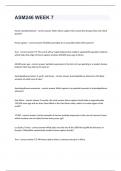
-
ASM246 WEEK 7 Arizona State University - Question and answers verified to pass
- Exam (elaborations) • 3 pages • 2024
- Available in package deal
-
- R282,76
- + learn more
ASM246 WEEK 7 Arizona State University - Question and answers verified to passASM246 WEEK 7 Homo neanderthalensis - correct answer When Homo sapiens first moved into Europe they met which species? Homo sapiens - correct answer Mobiliary/portable art is associated with which species? True - correct answer T/F The out-of-africa/ rapid-replacement model is supported by genetic evidence, which dates the origin of Homo sapiens at about 200,000 years ago in Africa. 40,000 years ago - co...
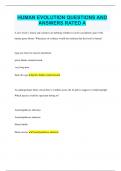
-
HUMAN EVOLUTION QUESTIONS AND ANSWERS RATED A
- Exam (elaborations) • 8 pages • 2023
- Available in package deal
-
- R194,94
- + learn more
HUMAN EVOLUTION QUESTIONS AND ANSWERS RATED A A new fossil is found, and scientists are debating whether it can be considered a part of the human genus Homo. What piece of evidence would best indicate that the fossil is human? large jaw bone for muscle attachment pelvic blades rotated inward very long arms thick rib cage pelvic blades rotated inward An anthropologist finds a fossil that is 4 million years old. Its pelvis suggests it walked upright. Which species could the specimen belong to...
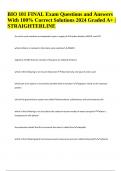
-
BIO 101 FINAL Exam Questions and Answers With 100% Correct Solutions 2024 Graded A+ | STRAIGHTERLINE
- Exam (elaborations) • 21 pages • 2024
-
- R360,81
- + learn more
BIO 101 FINAL Exam Questions and Answers With 100% Correct Solutions 2024 Graded A+ | STRAIGHTERLINE. the calvin cycle reactions are dependent upon a supply of carbon dioxide, NADPH, and ATP which cofactor is involved in the Calvin cycle reactions? NADP+ segments of DNA that are not part of the gene are called introns which of the following is not true of ribosomes they bind only one type of amino acid which part of an operon is incorrectly matched with its function? regulator--binds to the ...
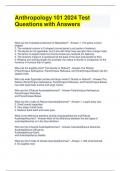
-
Anthropology 101 2024 Test Questions with Answers
- Exam (elaborations) • 6 pages • 2024
- Available in package deal
-
- R263,24
- + learn more
Anthropology 101 2024 Test Questions with Answers What are the 6 skeletal evidences for Bipedalism? - Answer-1. The pelvis is bowl shaped. 2. The vertebral column is S-shaped (curved spine to set center of balance). 3. The big toe is not opposable, but in line with other toes (we also have a larger heel). 4. The femur is angled inward so that the knees are centered (for balance). 5. The foramen magnum is positioned at the base of the skull and parallel to floor. 6. Relative arm and leg len...
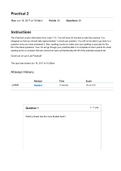
-
ANT3514C_ Introduction to Biological Anthropology. Practical 2. Quiz Score: 18 out of 20
- Exam (elaborations) • 18 pages • 2023
-
- R194,94
- + learn more
ANT3514C_ Introduction to Biological Anthropology. Practical 2. Quiz Score: 18 out of 20 Practical 2 This Practical covers information from Labs 7-12. You will have 20 minutes to take the practica l. It is designed so that you should take approximately 1 minute per question. You will not be able to go back to a question once you have answered it. Also, spelling counts so make sure your spelling is accurate for the fill in the blank questions. Your TA will go though your practical after it is com...
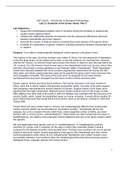
-
ANT 3514c Intro Biolog Anthro - University of Florida _ ANT 3514C – Introduction to Biological Anthropology Lab 11: Evolution of the Genus Homo: Part II.
- Exam (elaborations) • 11 pages • 2023
-
- R194,94
- + learn more
ANT 3514C – Introduction to Biological Anthropology Lab 11: Evolution of the Genus Homo: Part II Lab Objectives: Assess the morphological variation seen in hominins during the transition to a natomically modern Homo sapiens (AMH). Interpret the relationship between environment and the anatomical differences observed between Neandertals and Homo sapiens. Describe the mosaic of features found in recently discovered species of the genus Homo. Evaluate the implications of genetic e...
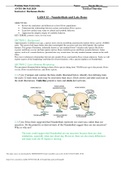
-
Wichita State University. ANTH 106 Biological Anthropology Lab Exam- LAB # 12 – Neanderthals and Late Homo. Q&A
- Exam (elaborations) • 4 pages • 2023
-
- R194,94
- + learn more
Wichita State University Name ANTH 106 Fall 2020 LAB # 12 – Neanderthals and Late Homo OBJECTIVES: • Review the similarities and differences in fossil Homo populations. • Understand t he relationships between archaic and modern Homo sapiens. • Learn how artifacts may relate to cultural and symbolic behavior. • Appreciate the adaptive origins of symbolic behavior. KEY TERMS: primitive traits, derived traits SECTION 1: Background Approximately 2 million years ago, a species more closely ...
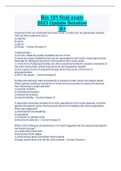
-
Bio 101 final exam 2023 Update Solution A+
- Exam (elaborations) • 22 pages • 2023
- Available in package deal
-
- R360,81
- + learn more
Bio 101 final exam 2023 Update Solution A+ Organisms that can interbreed with each other in nature but are genetically isolated from all other organisms are a: a) species. b) clone. c) genus. d) family. - Correct Answer-A Carbohydrates: a) act as a relatively quickly available source of fuel. b) serve as carbon skeletons that can be rearranged to form other molecules that are essential for biological structures and functions like nucleic acids. c) in the form of oligosaccharides ...

-
GLG 115 (Life of the Past) Final Exam Study Guide-Solved 100%
- Exam (elaborations) • 5 pages • 2023
-
- R204,70
- + learn more
How is island biogeography analogous to whole-earth biogeography? - ANSWER-earth is like an island in space How does an island's size relate to its diversity? - ANSWER-bigger islands have more diversity How does an island's distance from the mainland relate to its diversity? - ANSWER-the closer to the mainland, the more diversity Are all biogeographical islands actually islands? Give examples of some that are not. - ANSWER-no, alpine zones, ponds, and isolated forests How did Simbe...
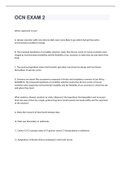
-
OCN EXAM 2022/2023 with 100% correct answers
- Exam (elaborations) • 12 pages • 2023
-
- R185,19
- + learn more
Which statement is true? A. Human ancestors with more diverse diets were more likely to go extinct during times when environmental conditions change. B. The proposed hypothesis of variability selection states that the key events in human evolution were shaped by environmental instability and the flexibility of our ancestors in what they ate and where they lived. C. The savanna hypothesis states that Hominin speciation was driven by abrupt and fast climate fluctuations of wet-dry cycles....

How did he do that? By selling his study notes on Stuvia. Try it yourself! Discover all about earning on Stuvia


